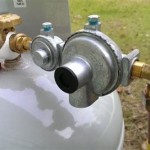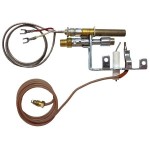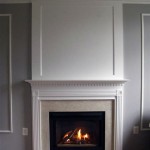Understanding Gas Fireplace Fans: Functionality and Benefits
Gas fireplaces offer a convenient and aesthetically pleasing alternative to traditional wood-burning fireplaces. They provide instant warmth and ambiance without the hassle of sourcing and storing firewood. However, the efficiency of a gas fireplace can be further enhanced with the addition of a gas fireplace fan. This article delves into the workings of gas fireplace fans, their benefits, considerations for purchasing, and factors to keep in mind for safe and effective operation.
A gas fireplace fan, sometimes called a blower, is an auxiliary component designed to circulate the heat produced by a gas fireplace unit. Typically, gas fireplaces radiate heat directly outward, which can result in uneven heating, with the area immediately in front of the fireplace becoming excessively warm while other parts of the room remain relatively cool. The fan addresses this issue by actively drawing cooler air from the room, passing it through the heated cavity of the fireplace, and then expelling the warmed air back into the room, thus promoting more uniform heat distribution throughout the space.
Gas fireplace fans are typically located at the base of the fireplace, often underneath the firebox itself. This placement allows them to effectively draw in the coolest air residing near the floor. The fan unit comprises an electric motor that powers a fan blade or impeller. As the blade spins, it generates airflow that moves the cooler air across the heated surfaces within the fireplace. The warmed air is then discharged through vents, typically located at the top of the fireplace, effectively circulating heat into the room.
The power source for gas fireplace fans is usually a standard electrical outlet. Some units may have a built-in thermostat that automatically activates the fan when the fireplace reaches a certain temperature. Others may have manual on/off switches or variable speed controls that allow the user to adjust the fan's output according to their heating needs. The construction materials of the fan are typically heat-resistant, often comprising metal components and durable plastics designed to withstand prolonged exposure to elevated temperatures.
Enhanced Heat Distribution and Efficiency
The primary advantage of a gas fireplace fan lies in its ability to improve heat distribution. Without a fan, the heat generated by a gas fireplace tends to rise and accumulate near the ceiling, leaving the lower portion of the room feeling cooler. A fan helps to break up this stratification by actively circulating the warm air downward and outward, creating a more comfortable and even temperature throughout the room. This can lead to a significant improvement in overall heating efficiency, as the fireplace is effectively warming a larger volume of space.
By more effectively distributing the heat, a gas fireplace fan can also reduce the amount of time required to heat a room to a desired temperature. This can translate to lower energy consumption, as the fireplace doesn't need to operate as long or at as high a setting to achieve the same level of comfort. In households with central heating systems, a gas fireplace fan can supplement the main heating system, reducing the overall demand on the furnace and potentially lowering heating bills. This is especially beneficial in large rooms or open-concept living spaces where heat loss can be significant.
Moreover, the improved heat distribution can reduce cold spots within a room. This is particularly advantageous in rooms with poor insulation or numerous windows, where heat loss can be concentrated in certain areas. The fan's ability to circulate air helps to counteract these cold spots, creating a more consistent and comfortable environment throughout the room. By minimizing temperature variations, a gas fireplace fan contributes to a more energy-efficient and comfortable living space.
Selection Considerations for Gas Fireplace Fans
When selecting a gas fireplace fan, several factors should be considered to ensure optimal performance and compatibility with the existing fireplace unit. Firstly, it is crucial to determine the appropriate size and airflow capacity of the fan. This is typically measured in cubic feet per minute (CFM). The CFM rating indicates the volume of air the fan can move per minute. A fan with a higher CFM rating will be able to circulate more air, making it suitable for larger rooms or fireplaces with higher heat output.
The physical dimensions of the fan are also important. The fan must be able to fit properly within the designated space at the base of the fireplace. Measure the available space carefully and compare it to the fan's dimensions to ensure a proper fit. Some fans are specifically designed for certain fireplace models, so it is advisable to consult the fireplace manufacturer's recommendations to ensure compatibility. Installing an improperly sized fan can lead to reduced performance or even damage to the fireplace unit.
噪音级别是应该仔细考虑的另一个因素。一些风扇比其他风扇更安静,在高设置下产生显着噪音。如果计划经常并在安静的环境中使用壁炉,请选择噪声较低的风扇。寻找具有噪声等级规格的风扇,通常以分贝 (dB) 为单位测量。分贝等级越低,风扇运行越安静。有些风扇还具有可调节的速度控制,允许用户在噪音和气流之间找到适当的平衡。
在能源效率方面,寻找带有节能电机的风扇。这些风扇在消耗更少电力的同时,仍然可以提供充足的气流。这有助于降低运营成本,尤其是在长时间使用壁炉的情况下。查找带有能源之星认证的风扇,表明它们符合能源效率标准。除了电机效率外,风扇的设计也可以影响其能源效率。具有优化叶片设计的风扇可以更有效地移动空气,从而减少能源消耗。
耐用性和制造质量是选择风扇时的重要考虑因素。选择由耐热材料制成的风扇,例如金属或耐用塑料,以承受壁炉产生的高温。检查风扇的构造质量,确保它坚固耐用且设计良好。在购买之前阅读客户评论和评级,以衡量风扇的可靠性和性能。质量好的风扇的使用寿命更长,需要更少的维护,从而节省了长期成本。
Safety and Operational Considerations
Proper installation and maintenance are essential for the safe and effective operation of a gas fireplace fan. The installation process typically involves placing the fan unit at the base of the fireplace and connecting it to a power source. It is crucial to carefully follow the manufacturer's instructions during installation to ensure that the fan is properly positioned and securely fastened. Incorrect installation can lead to reduced performance, overheating, or even safety hazards.
Regular maintenance is necessary to keep the fan operating smoothly and efficiently. This includes periodically cleaning the fan blades and surrounding area to remove dust and debris. Dust accumulation can reduce the fan's airflow capacity and cause the motor to overheat. Use a vacuum cleaner or a soft brush to gently clean the fan blades and vents. Avoid using water or harsh chemicals, as these can damage the components.
Overheating is a potential safety concern with gas fireplace fans. To prevent overheating, ensure that the fan is properly ventilated and that the airflow is not obstructed. Do not place any objects in front of the fan vents or block the airflow in any way. If the fan becomes excessively hot to the touch, turn it off immediately and allow it to cool down before attempting to troubleshoot the problem. Check for any signs of damage or malfunction, such as unusual noises or vibrations.
It is also important to be aware of the potential for electrical hazards. Ensure that the fan is properly grounded and that the power cord is in good condition. Do not use the fan if the power cord is damaged or frayed. Never expose the fan to water or moisture, as this can create a risk of electric shock. If you are unsure about any aspect of the installation or operation of the fan, consult a qualified electrician or HVAC technician.
Finally, be mindful of the noise level of the fan, especially during quiet periods. If the fan is too noisy, it can be disruptive and detract from the enjoyment of the fireplace. Consider using a variable speed control to adjust the fan's output and reduce the noise level when necessary. You can also try placing a sound-dampening material around the fan unit to help absorb some of the noise. By taking these precautions, you can ensure that your gas fireplace fan operates safely, efficiently, and quietly for many years to come.

Noisy Gas Fireplace Blower Here S How To Replace It Diy

Fireplace Efficiency Blowers And Why You Should Have One

Installing A Fireplace Blower Gfk4 Gfk4a In Heatilator Natural Gas

Gfk 4 Temperature Controlled 165 Cfm Fireplace Blower Fan Kit With Sd Control Knob

How To Buy A Gas Fireplace Insert Buyer S Guide From Regency

Do Gas Fireplaces Need A Blower Fireplace Tips

1pc Four Blade Fireplace Fan For Gas Oil Wood Stove Outdoor Camping Cooking Fishing Heat Powered Shein Usa

Wood Stove Fan 4 Blades Silent Fireplace Fixed On Pipe For Gas Pellet With 2 Magnets And 1 Spare Ring Fruugo Fr

Gpoty 5 Blade Stove Fan Heat Powered Fireplace Quiet Circulating Warm Air Saving Fuel For Wood Log Burner Gas Pellet Burning Black Com

Hot Ing Cooling And Heat Dissipation Box Gas Fireplace Thermostats Cross Flow Fan Motor China Tangential Blower Made In Com
Related Posts








